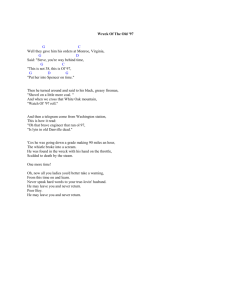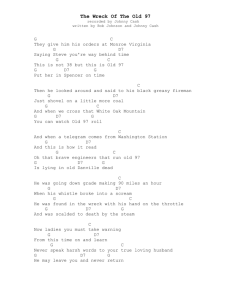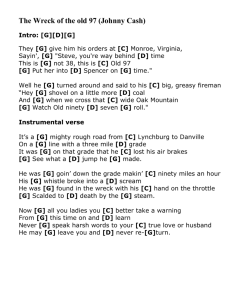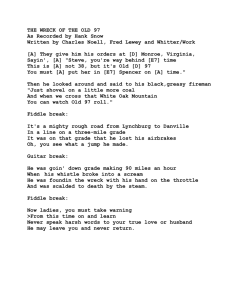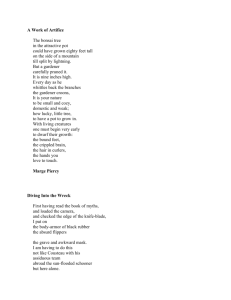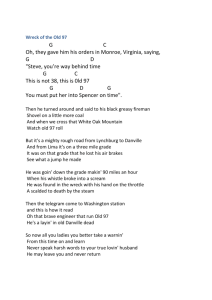Jean-Christophe Burvingt TRICOLOR EXPERIENCE IN THE FRAMEWORK OF THE CONTINGENCY PLAN MANCHEPLAN
advertisement
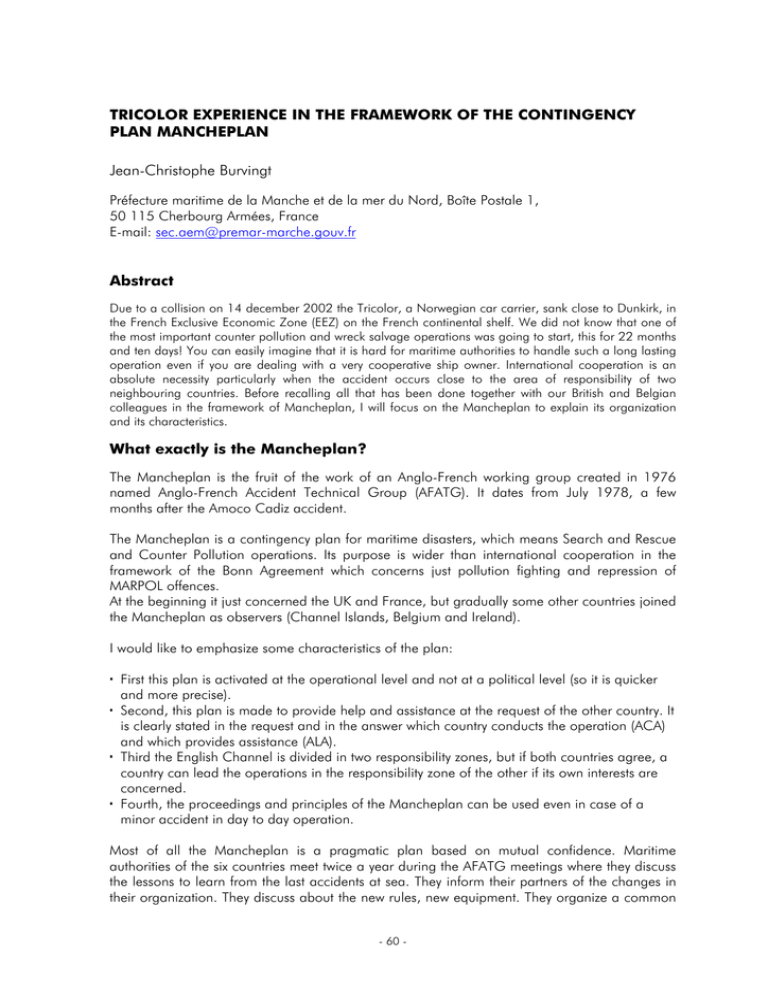
TRICOLOR EXPERIENCE IN THE FRAMEWORK OF THE CONTINGENCY PLAN MANCHEPLAN Jean-Christophe Burvingt Préfecture maritime de la Manche et de la mer du Nord, Boîte Postale 1, 50 115 Cherbourg Armées, France E-mail: sec.aem@premar-marche.gouv.fr Abstract Due to a collision on 14 december 2002 the Tricolor, a Norwegian car carrier, sank close to Dunkirk, in the French Exclusive Economic Zone (EEZ) on the French continental shelf. We did not know that one of the most important counter pollution and wreck salvage operations was going to start, this for 22 months and ten days! You can easily imagine that it is hard for maritime authorities to handle such a long lasting operation even if you are dealing with a very cooperative ship owner. International cooperation is an absolute necessity particularly when the accident occurs close to the area of responsibility of two neighbouring countries. Before recalling all that has been done together with our British and Belgian colleagues in the framework of Mancheplan, I will focus on the Mancheplan to explain its organization and its characteristics. What exactly is the Mancheplan? The Mancheplan is the fruit of the work of an Anglo-French working group created in 1976 named Anglo-French Accident Technical Group (AFATG). It dates from July 1978, a few months after the Amoco Cadiz accident. The Mancheplan is a contingency plan for maritime disasters, which means Search and Rescue and Counter Pollution operations. Its purpose is wider than international cooperation in the framework of the Bonn Agreement which concerns just pollution fighting and repression of MARPOL offences. At the beginning it just concerned the UK and France, but gradually some other countries joined the Mancheplan as observers (Channel Islands, Belgium and Ireland). I would like to emphasize some characteristics of the plan: First this plan is activated at the operational level and not at a political level (so it is quicker and more precise). Second, this plan is made to provide help and assistance at the request of the other country. It is clearly stated in the request and in the answer which country conducts the operation (ACA) and which provides assistance (ALA). Third the English Channel is divided in two responsibility zones, but if both countries agree, a country can lead the operations in the responsibility zone of the other if its own interests are concerned. Fourth, the proceedings and principles of the Mancheplan can be used even in case of a minor accident in day to day operation. Most of all the Mancheplan is a pragmatic plan based on mutual confidence. Maritime authorities of the six countries meet twice a year during the AFATG meetings where they discuss the lessons to learn from the last accidents at sea. They inform their partners of the changes in their organization. They discuss about the new rules, new equipment. They organize a common - 60 - exercise every year. As a result, when an accident happens, the partners know who to contact and who will rely on them. The plan has an introduction, one chapter dedicated to SAR and another to counter pollution. The other 20 annexes deal with communication with the media, radio-frequencies, characteristics of the assets, grids, etc. Also standing orders for a common chartered Emergency Towing Vessel (ETV) in the Dover Strait are included. Now let’s talk about the Tricolor… The saga of the Tricolor The Tricolor sank on 14 December 2002, during the night, very quickly (20 minutes), in relatively shallow waters (30 meters depth). The side of the vessel was only a few meters below the sea surface at high tide and the wreck was laying in the middle of a Traffic Separation Scheme. Thank God nobody died, nobody was injured or missing, even if the chief engineer got a real fright (he escaped through the funnel!). The wreck caused an immediate threat to shipping in the major sea route in the North Sea. Another concern was the quantity of bunker oil remaining in the wreck which was estimated to 1990 tons of IFO 380 (same viscosity as the oil carried by the Prestige!). Préfect maritime in Cherbourg, who is the French maritime authority for the Channel and North Sea, sent immediately a legal notice to the ship owner to oblige him to take relevant measures to put an end to the threats of pollution and danger for navigation. The ship owner acknowledged to our legal notice, and chartered immediately a guard vessel to put near the wreck. At the same time the Mancheplan was activated to get assistance from the neighbouring countries, and of course we sent them information about the accident which was very close to their areas of responsibility. Ensuring safety of navigation The most immediate risk was the risk of another accident. So we had to prevent collision with the wreck. Navigation warnings have been broadcasted by the local MRCC (Gris-Nez, Dover, Oostende). We decided to put a state ship in the vicinity of the wreck to reinforce information and to put a buoyage around the wreck. The first ship doing this hard duty was the Belgium frigate Wandelaar. Afterwards some French ships from customs and Gendarmerie maritime came from Boulogne and Cherbourg. Two buoys have been settled the day after the collision by the French Buoyage service. Despite these actions a German coaster collided with the wreck on 16 December. As a result, we decided to put a full buoyage around the wreck complying with the recommendation of the International Maritime Signalisation Organization, and to put two state ships in the vicinity. Two weeks later, the Vicky, a Turkish tanker, carrying 66,000 tons of kerosene also struck the submerged Tricolor and an oil spill occurred. - 61 - At this time, I want to focus on two things: 1) the Tricolor accident happened just a few weeks after the sinking of the Prestige, so the majority of the European counter pollution resources were in Spain, and 2) we were just a few weeks before the second Gulf War. Therefore getting a Royal Navy ship was very difficult. First of all because our British colleagues of MCA had no power on Royal Navy and second the biggest ships which are seaworthy were all gone far. Fortunately our Belgium colleagues were still there and decided to share the burden with us. So we organized a planning every month with two ships on duty for a week. I must say that without the Belgium help it would not have been possible for us to maintain two state ships at the same time here. This situation has been going on for almost eleven months (when the remaining parts of the wreck collapsed giving more than 16 meters depth to navigate). The figures are impressive: 25 state ships involved, 773 sailors, 325 days of surveillance, information provided to 7,076 merchant ships, 98 collisions avoided by ships whose master or officer of watch did not know the position of the wreck. Monitoring pollution I mentioned before that the ship owner was very cooperative. He immediately sent a guard vessel and also within two days after the collision a ship to remove the bunker oil. We had to monitor the situation on the basis of three daily reports at the beginning. So we organized an aerial surveillance plan with our British colleagues of CNIS, our Belgium colleagues of MUMM, and the French Customs and French Navy aircrafts (do not forget that most of the time the French remote sensing aircrafts were most of the time off the Spanish Coasts). This planning was established on a weekly basis and I tried to take the opportunity of every scheduled routine flight to avoid disturbance for services and to minimise the costs of the operation (because after all we have to try to be refunded by the ship owner’s insurers). This planning was organized to avoid any aerial hazard. The oil recovery has been completed at the middle of February 2003. Aerial surveillance continued on a different schedule and resumed on a two flights per day during the cutting operations. During the first year 310 hours of surveillance (175 France, 77 UK, 58 Belgium) have been dedicated to monitoring the possible oil spills of the wreck. Counter pollution response When it appeared that the only solution to remove the wreck from the seabed was to cut it in sections and then to lift them and bring them on the shore, it became obvious to the maritime authorities that oil release was a permanent risk (even if the pumping has been done very seriously, oil fractions still remain in a wreck). An invitation to tender has been published in February with a deadline in April. The owner and P§I have contracted a consortium headed by Smit to cut the wreck in nine sections by means of a specially designed cutting wire system that was used in the lifting of the Russian submarine Kursk in the Barents Sea. Each wreck section, including the cargo inside (luxury cars), was lifted by means of two sheerleg cranes barging of 3,000 ton lifting capacity. France, in accordance with Belgium and UK, asked the contractor to have an oil spill contingency plan. In this plan it was stated that the first tier response was in charge of the - 62 - contractor with appropriate assets and trained crew. The second tier response (major oil release) was in charge of France and Belgium. So we had to have a ready duty counter pollution ship available during all the cutting and lifting operation. During the last part of the operation on the working site (May to September 2004) when the giant crane was grabbing the collapsed parts of the ship, the same counter pollution system with two response tiers has been implemented. It means that during the first year we had to plan aerial surveillance, to plan navigation control, and to plan oil spill response ships. You cannot do that if you do not have goodwill men (or women) in front of you. Fortunately I knew all my opposite numbers. Sharing information and decisions together Leading such an important operation close to the borders of other countries is not possible if you do not share the information and take advice to take common decisions. All the important working meetings we had with the ship owner’s representatives were held in Dunkirk with the French shore authorities and the British and Belgian relevant authorities. All the press releases and releases for French ministries have been sent to our foreign partners. More than 12 meetings have been held in Dunkirk (even if it was a burden to organize meetings far from our office) to facilitate the participation of the Flemish Governor Paul Breyne and other relevant Belgium authorities and the MCA representatives of Dover. 87 official communiqués have been addressed to the UK and Belgium authorities. Conclusion The Tricolor case is one of the most important salvage operations ever been carried out in the world. It is a unique example of cooperation with a ship owner taking his full responsibility, the fantastic know-how of Dutch and Belgian salvage companies and the quality of relationships between Mancheplan partners. Even if the Tricolor spill turned into one of the most serious incidents in Europe for birds (but we had to face pollution coming up from Prestige), we can consider that we succeeded all together in dealing with the pollution threat and the navigation danger in this busy and sensitive area. - 63 -
